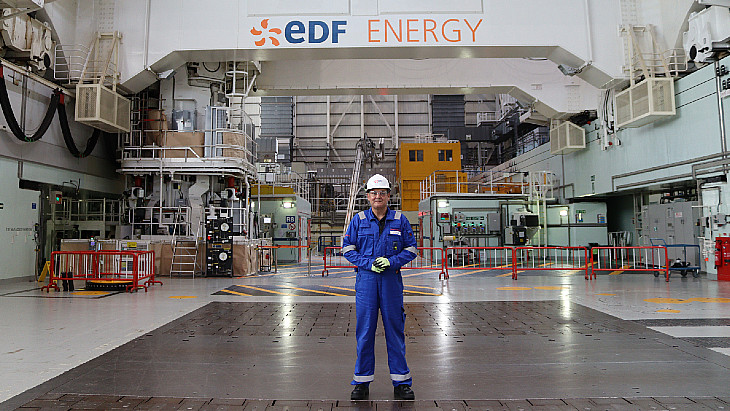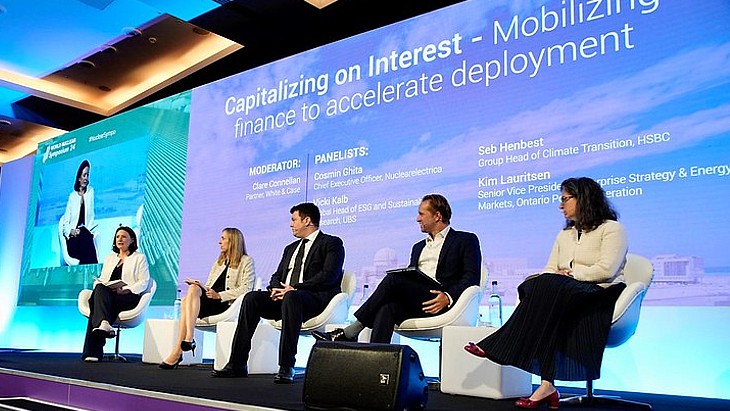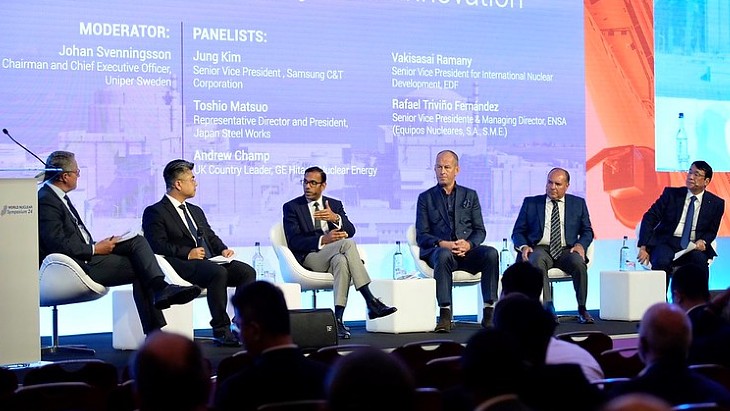Q&A: Core Power Chairman and CEO Mikal Bøe

How could nuclear energy transform commercial shipping?
This is a USD7 trillion per year industry at the heart of global trade which is desperate for a clean energy solution because it must reduce its CO2 emissions by 50% of 2008 levels by 2050, according to a mandate from the United Nations International Maritime Organisation (IMO). Failure to do so would mean that our share of global pollution could grow from 3% currently to 10%, or even 50%, if the world goes green around us. More importantly though, the MSR is a disruptive technology that can put a new competitive edge back into global trade, of which shipping is the backbone since 90% of all international trade is carried at sea. The shift to advanced nuclear will be as revolutionary as the sail-to-steam transition of the 1840s because the MSR technology can make ships faster and vastly more efficient. For the nuclear industry, it’s a unique opportunity to create the ultimate ‘nth-of-a-kind’ mass production system around a hugely positive, deep-impact narrative. Our aim at Core Power is to create an integrated power system where the ship is fuelled for life, which is 20-30 years depending on the type of ship, which in turn avoids handling spent nuclear fuels in ports. That puts a lid on concerns about the risk of proliferation. If we can build MSR technology and the ecosystem for deploying it, this can provide enough durable, clean power for large boxships to do ‘30 knots for 30 years’. In addition, we believe that ships powered by advanced nuclear can easily provide 100% clean electric power to the ports they call in, which would change the commercial shipping industry's contract with the international community in a hugely positive way, both for the public and the environment.
Why are you focusing on container ships?
Large container ships are different to bulkers and tankers in that they carry most of their cargo above the waterline, which is why their hulls are streamlined to travel through the water faster, but they need an enormous amount of power to achieve high speeds. The diesel engines onboard consume more than 200 tonnes of fuel per day, which produces over 600 tonnes of CO2. That's both very polluting and extremely expensive. For many years, the market for those ships has been very tough and they have been forced to slow down to save costs. Ships that were designed to sail at around 25 knots have been doing 15 knots or less, to save fuel. That has slowed down supply chains, and as more ships were built, created overcapacity in the market. What we now see is the inevitable introduction of carbon taxes and pollution penalties, which will be passed on to consumers and cause inflation in the price of industrial components and durable consumer goods as the cost of commercial shipping increases. Smaller containerships will benefit from zero-carbon fuels like green ammonia that we aim to produce using power from the MSR to avoid most of those penalties. The larger, much faster container ships eventually powered by advanced nuclear reactors that do not pollute the air or the sea and which power the ports in which they call, would be immune to these entirely.
How can MSR technology produce a speed of 30 knots?
According to the naval architecture and marine engineering we have today, these are the speeds that modern hulls are already capable of, and so it's more a matter of having a power rating that stretches out the advanced nuclear fuel cycle in a way that avoids refuelling and creates a practical maintenance regime of the power systems onboard. We believe it will be possible to reduce a standard Trans-Pacific voyage from 12 days currently to around 7 days, and that the long-haul Korea-Rotterdam round-trip could be reduced from 80-85 days to as few as 45 days. That kind of speed means shippers could avoid the Suez Canal altogether, saving themselves USD1.5 million in transit tolls and the possible delays that such chokepoints represent. By being able to go around the Cape of Good Hope (tip of South Africa) in the same time it would take a slower ship to pass through the Suez Canal, and avoiding a fuel stop at Singapore, just makes the supply chain so much more reliable. The obvious economic benefits of this are enhanced by the fact you wouldn’t need to stop for fuel. If we get this right, the MSR would keep powering these ships for their lifetime, which is around 30 years. Bulk carriers, tankers and cruise ships have different lifespans, and the technology could be calibrated to each sector. We would also aim to continue to use the fuel from the MSR long afterwards, by loading it into new generations of MSRs. Recycle and reuse - that must be the future of nuclear.
How would you characterise the shipping and nuclear industries?
Shipping has an inherent ingenuity, not merely to survive but to thrive in the most hostile of environments. Its engineering is so good and so established that it can delegate authority to a crew that are living on a piece of steel in the middle of the ocean facing waves of up to 40-metres high and transporting valuable and precious cargo. Our ability to adapt - to terrible weather, rough seas, wars, famine and even pirates - and to design and use durable systems, reliable standards, classification rules, insurance models and legal frameworks to create the safest mode of transport that exists today, despite the odds, is testament to the value of thousands of years of experience. If you take all of that and add the smartest nuclear guys in the world designing the most fuel efficient small atomic power system, then you can have the best of both worlds, resulting in a container ship that travels twice as fast for twice as long. The nuclear industry innovates to make the most of new scientific knowledge and technological advancements. The MSR concept itself is thanks to Alvin Weinberg and Eugene Wigner doing exactly that back in the 1950s, during the slide-rule era with a sense of a brave future but limited to manual calculations and experiments. Now we have supercomputers that can emulate scenarios it would have taken decades to complete back then. We also have so much more knowledge about metallurgy, advanced chemistry and reactor physics. We are already living with the effects of climate change. We all see it, feel it and fear it. There's a growing realisation that we can't solve the climate crisis without nuclear energy; it must be a major component along with weather-dependent fossil fuel saving devices, like solar and wind, and a good complement to dispatchable geothermal and hydro. We now know that some 8.5 million people die every year from air pollution caused by the burning of fossil fuels, while nuclear medicine alone (even not counting nuclear power), saves at least that many lives every year. Imagine then what we could do with advanced nuclear. Anyone who is worried about nuclear waste should be heartened by the fuel efficiency of the MSR, which produces orders of magnitude less end-of-life residue. They should also realise that the total volume of spent nuclear fuel generated by all the world’s conventional reactors since the first pile in 1942, equals the volume of toxic sludge produced every hour from burning of coal to make electricity. Advanced nuclear can change all that.
What is unique about the MSR from among advanced nuclear technologies?
In an MSR the fuel and the coolant are the same, so you can't lose either. The fuel salt, which is the coolant is impervious to radiation damage and remains chemically stable to be used and recycled for a very long time. An MSR operates with ambient pressure only and the fuel is always liquid when critical. At regular power, the temperature of the reactor would remain at around 600 degrees Celsius, which is double the temperature you can get with a pressurised water reactor. That’s useful for really efficient power conversion systems and for industrial applications such as producing green hydrogen and ammonia fuels for shipping. An MSR can be made small and affordable and be used on land, at sea or even in space. Anything you can imagine that needs industrial heat can use it. We're focused on maritime because we believe it's one of the hardest industries to abate; it's probably the one that's going to lag behind in the clean energy transition and it's the one that needs a competitive advantage and can afford to pay for it. On an MSR powered ship, the idea is that the reactor will be used until the vessel is decommissioned. The MSR itself, or the fuel from the MSR, can then be used for the next generation of reactors and next generation of ships.
How do you convince the shipping industry that an MSR is safe?
Nuclear-powered ships have so far mostly been naval defence, but advances in nuclear technology now offer the possibility for commercial applications. We believe this is a perfect civilian grade technology that neither threatens the tactical superiority of a nuclear navy, nor poses a threat to the peace and stability of port states. It’s very important that this is highlighted so that those who are tasked with handling export controls and licensing can be fully confident that civilian nuclear propulsion is proposed for all the right reasons. We will absolutely rely on every reactor being carefully controlled, monitored and managed by vetted, qualified personnel, and it being installed only on floating assets that are flagged in appropriate jurisdictions like the USA, the UK and France or, less obviously, Japan, which is one of the largest shipping nations. MSR technology allows for a new way to do nuclear, rewriting the contract with industry and the public. Safety is always first priority, and the passive safety features of the MSR substantially enhance its suitability for maritime applications. As for ports, nuclear proliferation is always going to be a political hot potato. If you take a conventional PWR naval defence reactor and use it with reactor grade fuel in a commercial ship, you'll have to refuel it every couple of years and that inevitably means handling spent fuel in ports. For that to be political acceptable, every country with a port would have to be a nuclear nation, which would be putting the cart before the horse because it’s not going to happen any day soon. What we have with the MSR is a technology that opens that door, allows for a more widespread and distributed use of advanced nuclear in a maritime setting, and since it is so efficient, we can avoid the need for refuelling. That means the ship provides the benefit of clean power in port and then departs leaving no environmental footprint.
How do you manage the public's concern of a nuclear incident at sea?
Any MSR used in a maritime application will be located deep inside the hull and at a long distance from the reactor shielding wall to the edge of the hull. Accidents at sea do happen - ships sink, ships catch fire, ships collide - but an MSR will always be well protected and in the event of a catastrophic emergency, shut itself down thanks to its passive safety characteristics. The idea is that even if there is no crew left onboard, the reactor system is passively shut down, and left to cool inside the reactor compartment, without polluting the environment. There's no gas pressure in an MSR and therefore no way for radiotoxins to be expelled into the environment. The MSR fuel would simply cool until it's a solid rock, and that solid rock should be entombed inside the reactor vessel. If the ship sinks, the MSR will remain in its box. A ship may be lost at sea and may sink to 8000 metres on the ocean floor, but even then, it would not pollute the environment.
How would you insure a nuclear-powered commercial ship?
The shipping industry is used to complex insurance and there's plenty of actuarial evidence that nuclear insurance for maritime applications can build upon. There are open questions though: Where and when does the liability kick in? What is the loss adjustment process? How is risk insurance re-insured and by whom? As an example, The Oil Pollution Act of 1990 (OPA90), which came into force after the Exxon Valdez disaster in Alaska, introduced the concept of unlimited liability for oil tanker operators. Think of that: You're transporting oil in a steel hull across the roughest oceans in the world and you have unlimited liability if the oil spills out. It's not beyond the wit of man to get a proper insurance regime in place for nuclear-powered ships. Underpinning any marine insurance policy is always a solid set of ship classification rules that guide the construction, maintenance and operation of a ship. We are working with the leading Classification Societies to re-write those rules for maritime applications and lay that foundation. Then follows a proper insurance regime which again lays the foundation for construction and operational finance. Class rules are the key and we’re building a strong industry group that’s tackling that.
How would conventions governing shipping need to change?
There are three main international conventions under the purview of the IMO: for the Safety of Life at Sea (SOLAS); for the Prevention of Pollution from Ships (MARPOL); and on Standards of Training, Certification and Watchkeeping for Seafarers (STCW). The key part of IMO regulations related to nuclear ships and nuclear propulsion is under SOLAS. Chapter 8 has a resolution on the operation of nuclear ships, which was passed almost unanimously by all members of the IMO in 1981. It's getting kind of dusty now because it's predominantly written for the PWRs of the 1970s, so it needs modernising. The IAEA is also properly engaged in this topic. It's a matter of reviewing and amending existing rules to make them relevant to new and better technologies, and not about writing new rules, but it still takes time. The IMO is a UN agency and any proposal to amend a convention needs to be brought by flag states; we can't do it alone as a private sector industry, but we are building the early support for maritime applications of advanced nuclear reactors from the most relevant nations already. The Convention on the Liability of Operators of Nuclear Ships (1962) is also an important consideration.
What timeline are you working to?
The reactor development team aims to have a proof-of-concept for the MSR ready by around 2025. Before that, each member of the team has its own milestones. As the commercialisation architect for maritime applications, we at Core Power aim to have the first set of new classification (design and operational) rules for maritime assets available to the market by 2023. These classification and insurance rules need to start to come together in different jurisdictions, and we aim for that to go into the 2024/2025 work stream at the IMO. The ensuing process should take about five years, which should correspond with demonstration projects at sea for the MSR by the turn of the decade. In the meantime, we are building all the meaningful relationships we can across a broad set of stakeholders in the maritime and nuclear sectors so that we are ready to rumble when the green light comes on.
What are the other uses for the MSR you are working on?
Predominantly, we are focused initially on maritime energy applications, including the production of hydrogen from seawater, and green ammonia as a fuel to be used on smaller ships. This is a transition fuel for heavy transport and industry which we cannot ignore. We're working with industry stakeholders to help develop a market for green ammonia (produced by adding nitrogen to hydrogen) and green methanol (produced by adding CO2 from carbon capture and storage) and for the conditions to be in place for that to be a meaningful market for MSR power. There is however a physical constraint for those fuels. The global shipping fleet has about 100,000 ships that are over 100 tonnes, of which the largest 7000 ships are responsible for close to 50% of air pollution from our industry. We think the MSR is highly appropriate as a marine reactor technology for industrial scale production of green fuels for all but these largest ships. For the largest 7000 ships it makes sense to consider the MSR as the main means of propulsion and that would make a big difference in reducing air pollution from shipping. Ammonia as a marine fuel has a lower specific gravity and only about 40% of the energy content of current marine fuels, which means it is not appropriate for large ships doing long voyages. Hydrogen itself is impossible to scale at that level. But ammonia is feasible for smaller ships, like ferries, coastal vessels and ships doing shorter voyages. The oil and gas industry talks about 'grey' and ‘blue’ hydrogen, but almost all of that comes from a process known as steam methane reforming, which today produces more greenhouse gas emissions and more CO2 than all of shipping does together, and an awful lot more than can be abated by using the hydrogen produced. Hence, if shipping moves to hydrogen made in that way, we will boost the production ten-fold, and we'd be absolutely going in the wrong direction, simply pushing pollution from the sea on to land. No one should be proposing that as a solution. The point is, how stuff is made and not just why we're making it. When making green hydrogen and ammonia with MSR power, 'zero emissions' would come as standard throughout the whole production process.
How do you approach family-run shipping companies?
Family-run shipping companies dominate our industry and they think in terms of several future generations to come. Each of these companies knows that by the time the baton is handed to the next generation, it should be 'future ready'. That's the perfect environment for us to operate in. Only the fittest survive in shipping and the ones that make the required transitions understand that it is not just about changes to technology, but also about changes to the entire business model. As far as adapting to the next generation, which will be living through the clean energy transition, let's see who's still left standing at the end of the day. There will be new participants, and the way we do things will change. Advanced nuclear for commercial shipping is quite simply the closest to the 'silver bullet' we've ever been, both to solve the climate challenge and disrupt our industry at the same time. It has an inevitability to it.










